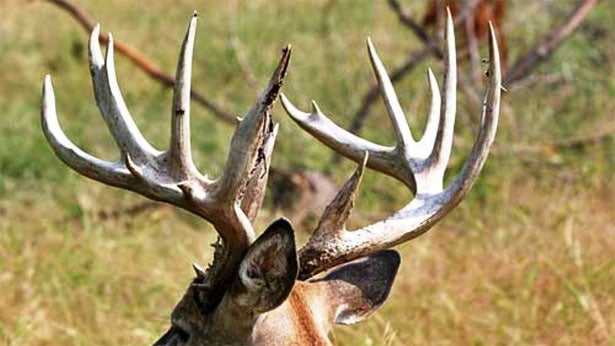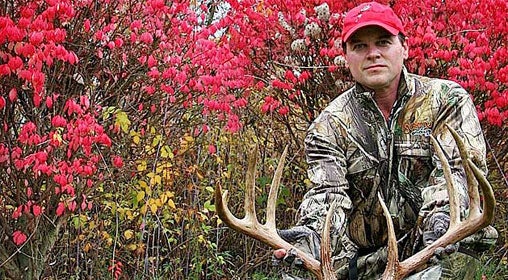Big Buck Bingo
OutdoorChannel.com 01.06.14

By: Posted 12-24-2013 OutdoorChannel.com in Story by Don Mulligan
Permitted use provided by: OutdoorChannel.com.
Among the ranks of deer hunters, there are a growing number of enthusiasts more than willing to end the season empty-handed. Many of them are even happy to string together several years without killing a deer.
Some call them trophy hunters, but they are usually much more than that. They wait on bucks that are 1 in 1000, or might not even exist.
And though they eat the game they kill, they define success much differently than the average meat hunter. For this patient set of hunters, filling a tag just for the sake of filling it is nonsensical, counterproductive and bad for the sport.
These are the men and women who don’t even raise their bow in October for a 160-inch buck because they understand truly old bucks don’t start moving until November and December. In short, their bar is typically set higher than everyone else’s and they know what it takes to clear it.

The requisite criteria to shoot is different for all of them, but they all still strive to have one thing in common: to have access to land capable of growing and holding the kind of rare buck they seek.
Not all whitetail states grow bucks in sufficient numbers to merit holding your shot at a 160-inch buck, and even in the states that do, not all counties or properties are always a good bet.
Worth the risk
Most of these hunters begin their search for hunting land to own or lease with a detailed study of Boone and Crockett’s trophy list by state and county. Few are surprised the list reveals the northern plains and Midwest states are home to the greatest number of big bucks, but the numbers don’t always tell the whole story, why some are trending up or down or why some are better than other.
Wisconsin tops the list of big buck states by a wide margin, and is an untouchable beast when it comes to trophy whitetail. From 2008 until 2013, hunters there killed 426 record book whitetails; almost twice as many as second-place Ohio.
What is odd about Wisconsin’s ability to produce so many big deer is that they rate poorly on many of the criteria big buck gamblers require.
Wisconsin’s average farm is only 201 acres, smaller than the average for Indiana (254) and nearly half the average size for productive states such as Minnesota (345), Iowa (355) and neighboring Illinois (377).
Trophy hunters rightfully understand larger, privately owned parcels give deer a better chance to live beyond their first or second rack.
Wisconsin also has one of the highest hunter densities among big buck states, something that often equates to more small bucks being harvested. According to The Quality Deer Management Deer Association, they support 13.7 hunters per square mile. That makes them the fourth most crowded deer hunting state behind three states that almost never put a single buck in the books.
Then why does Wisconsin turn out so many big bucks?
Because of something no statistician can quantify: the mindset of the deer hunting populace there.
When Wisconsin Gov. Walker appointed Dr. James Kroll as a Deer Czar, it illustrated how important deer hunting was to everyone in the state, and how much nearly everyone there valued not only deer, but big deer.
While many did not agree with the actions taken by Dr. Kroll, most agreed deer were important enough for the Governor to get directly involved.
Other states are good bets as well, but for different reasons.
Ohio killed 228 record book bucks from 2008 to 2013 and Illinois took 219 during the same period. They achieved those numbers differently than Wisconsin, however.
While the hunters in those states likely also value deer and deer hunting like Wisconsin hunters, they also structure their seasons to allow more deer to survive from one year to the next.
Most states hold bow seasons for whitetails from September until January, but gun seasons shape deer herds.
Bucks in Ohio are only legally hunted 13 days a year (including youth season), and firearms seasons don’t begin until December. Illinois only allows hunters to shoot bucks with firearms for 12 days, starting in late November.
This is critical, and it results in a large carry over of bucks from one season to the next. Big buck gamblers understand this and confine their hunting to states with the shortest gun seasons, especially if they are scheduled out of the rut, when mature bucks are most vulnerable.
Other factors big buck hunters consider when choosing a farm and state to hunt include the culture of outfitting in the state and area, the number and type of properties adjacent to a hunting property, neighbor’s mentality regarding harvesting bucks, recent history of Epizootic Hemorrhagic or Chronic Wasting Disease, the actual layout of the property and whether it can easily be protected from trespassers and poachers.
A bad bet
Despite being surrounded by monster buck producing states, Michigan is a really bad bet for big buck hunters. Most hunters there will never see a 160-inch deer in their lifetime, let alone have a chance to pass on one and eventually see a 180-inch monster.
The northern third of the Lower Peninsula and the entire Upper Peninsula are dominated by big woods and almost never grow big bucks these days. Odds are better in the south, but where hunter mentality aids mature deer in Wisconsin, it hurts them in Michigan.
Michigan’s average farm size is 191-acres and, sadly, too many bucks, regardless of antler size, get killed every year across the state. It is part of the culture in Michigan that any buck is a worthy target, though when asked, nearly all Michiganders wish they could shoot a big buck.
Like the 800-pound man who points to the 1000-pound man as evidence of someone who really needs help, Michiganders need to look no farther than Indiana to expose a state’s deer herd in worse shape than theirs.
While Indiana’s Boone and Crockett record book entry numbers look pretty good over the past five years (184), they don’t tell the horror story that is presently unfolding in the Hoosier state.
Most of the big bucks taken In Indiana were killed prior to 2012, when the Indiana Department of Natural Resources teamed up with politicians to restructure the deer seasons. As a result, last year Indiana dropped from being the fourth best state to kill a record book buck to ninth.
Most in Indiana believe this is just the beginning of its fall from nobility.
Where Wisconsin created a political position that recognized the value of deer there, Indiana IDNR officials teamed up with politicians behind closed doors and devised a plan that sportsmen and women did not want.
The plan reveals how out of step the IDNR is with hunters, and treats deer like vermin to be exterminated.
The shortsighted plan was clearly devised to maximize profits from the sale of new deer tags, but fails to recognize or identify a future for deer in Indiana.
The new rules allow buck hunting with firearms for 34 days a year, starting during the peak of the chasing phase of the rut. Additionally, there is an additional 11-day late shotgun antlerless season that runs into January, and the introduction of crossbows from September until January.
The IDNR and politicians in Indiana took what were already the most liberal gun seasons in the Midwest and made them longer and more liberal.
To illustrate just how out of step the new deer plan is with Hoosier hunters, The Indiana Deer Hunters Association and The Indiana Bowhunters Association, the only two statewide deer hunting groups in Indiana, both sent letters to the IDNR after the rules were adopted, severing ties with them on any future collaborations. Those letters marked the first time either organization ever ended communication with the IDNR in history.
The only silver lining resulting from Indiana’s bureaucratic handling of the deer herd has been the increased value of hunting properties in neighboring Illinois and Ohio, two great bets for big buck gamblers. Hunting properties just across the border from Indiana are now selling and leasing as soon as they are listed.
Waiting on a trophy-class buck is not for everyone and what qualifies as a trophy rightfully varies by hunter. Regardless of the definition, however, some states, counties and farms are a much, much better bet than others.
